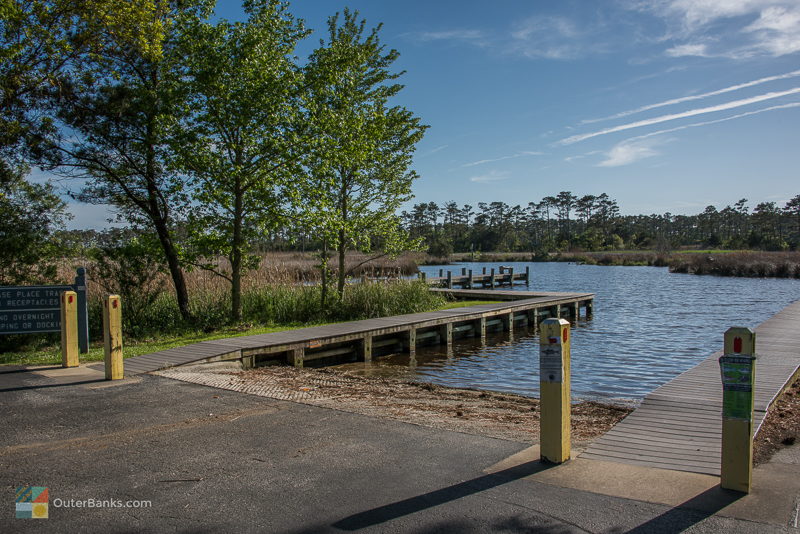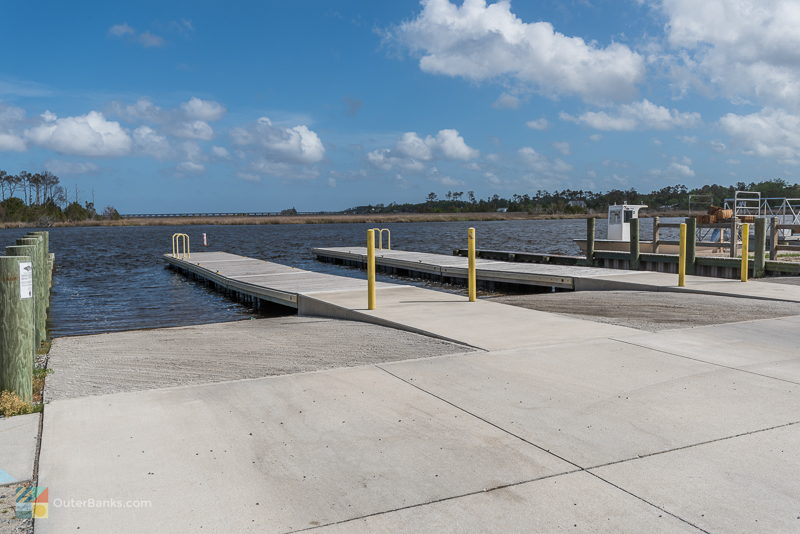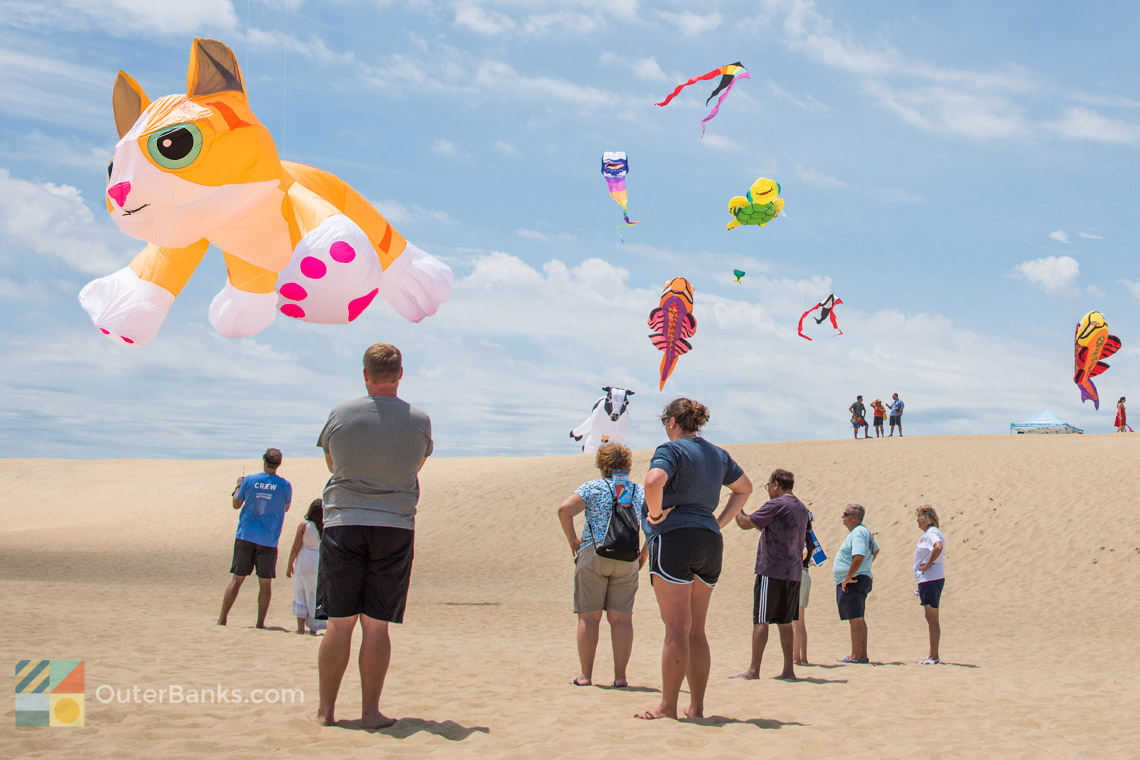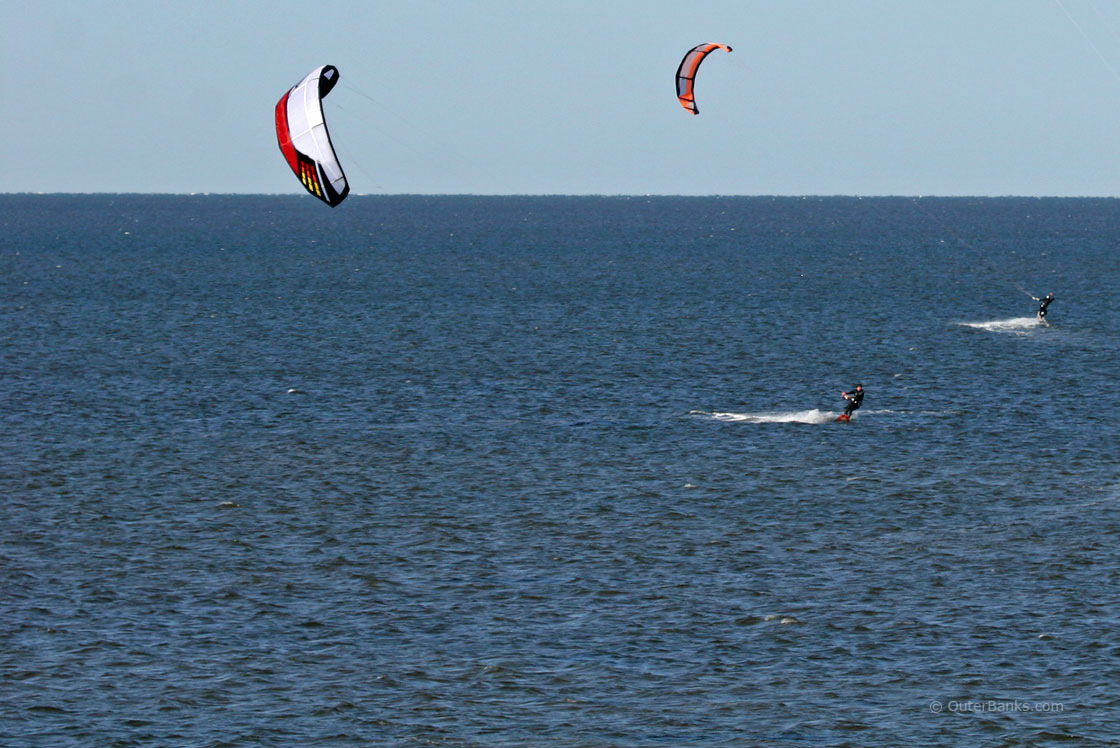The Croatan Sound is one of the smaller sounds on the Outer Banks, but is certainly no less picturesque or worthy of exploration for Roanoke Island visitors or Outer Banks travelers arriving from the west.
The Croatan Sound basically separates Roanoke Island and the towns of Wanchese and Manteo from the mainland, and essentially creates the island itself, buffering it from the small town of Manns Harbor and the Dare County Mainland with a wide body of saltwater that generally circulates like a slow moving river, depending on the wind and current directions.
Though seemingly hidden on the western side of Roanoke Island, day-trippers to Manteo or Wanchese will have ample time to discover this scenic Outer Banks attraction, and folks who travel well off the beaten path to the little town of Manns Harbor will find even more avenues to discover the waterfront, from small 2-lane residential roads to public parking areas that overlook the water.
If you're on the hunt for adventure, or simply want to explore every major (and minor) body of water on the Outer Banks, then take a Sunday drive across the Croatan Sound. Quiet, scenic, and always full of wildlife, the Croatan Sound is an attraction that everyone will consider a breath of fresh air.

History of the Croatan Sound
The Croatan Sound, like most all Outer Banks bodies of water, had very gradual roots in its formation. When the first European explorers arrived in the late 1500s, this sound literally wasn't even on the map. Instead, explorers who dared to travel to the western edge of Roanoke found only miles of swamps and marshlands which made a fragile connection to the mainland. This may have affected the original geography of the first settlements as the explorers opted to build villages near the Fort Raleigh National Historic Site, bordering the Roanoke Sound, and not the western side of the island. This locale allowed ships with goods, supplies, and even settlers to have a relatively easy route to and from the settlement.
The Croatan Sound was non-existent for centuries, in fact, and remained a swampy marshland well into the colonial period and beyond.
This all changed, however, as the Roanoke Inlet, which was once an inlet that cut across the barrier islands of the Outer Banks just east of Roanoke Island, began to close. The inlets on the Outer Banks are notorious for moving from one stretch of sand to another, either by a swift storm or a simple migration of water when a new inlet forms.
Roanoke Inlet was no exception, and as new inlets were opening or strengthening north and south of it, Roanoke Inlet began to close.
The inlet was originally the deposit locale of 9 rivers that flowed from the Albemarle, but after its closure, the water needed more room to move. As a result, the water simply moved into the western borders of Roanoke Island, and within 40 years, (between 1780 and 1720), as the inlet closed, the Croatan Sound grew and grew until it became the behemoth body of water it is today.
Because this large deposit of freshwater was infringing on a marshy area with a sandy and not stable bottom, the inlet that formed was exceptionally deep, with water depths ranging to 10' or more. Even today, the Croatan Sound remains one of the deeper sounds on the Outer Banks, as well as having the distinction of being one of the least saltiest, due to the river deposits and its proximity to the mainland. Though it connects to the Pamlico Sound, the freshwater that is pushed through from the rivers keep salinity levels lower than the Pamlico or Roanoke Sound, which also remains closer to the ocean and relatively close to Oregon Inlet.
As tourism slowly began to grow on the Outer Banks and Roanoke Island, it became clear that the small ferry that had run across the Croatan Sound providing access for visitors was inadequate, and in 1957, the Manns Harbor Bridge opened, providing visitors with a safe and quick means across the Croatan Sound and into the town of Manteo.
Formerly named the William B. Umstead Bridge, drivers using this two-lane bridge had to drive first through the small town of mainland Manns Harbor before crossing the sound at one of its narrower points, and then were dropped off at the very northern edge of Manteo.
This bridge was the main connection from mainland North Carolina to Roanoke Island and ergo the rest of the Outer Banks for many years, but in the late 1990s, tourism on the Outer Banks had soared and the state of North Carolina was looking for more effective ways to allow NC residents easy access to the Outer Banks. At the time, a trip from Raleigh, NC to the Outer Banks took a good 5 hours across the mostly two-lane NC Highway 12, while rival, (and out of state), vacation destination Myrtle Beach was only a 2.5 hour drive away.
As a result, more four-lane portions of US 64 were constructed, and the Manns Harbor Bridge was effectively "replaced" in 2002 with the Virginia Dare Memorial Bridge.
The bridge opening was marked with a celebration and ribbon cutting, and even included an inaugural drive across by Andy Griffith, who was driving a classic car. As a Manteo local legend and original thespian at the Lost Colony outdoor drama, Griffith now also holds the honor of being the first person to cross over the Virginia Dare Memorial Bridge.
This four-lane bridge has the distinction of being the newest, longest, and widest bridges across the Croatan Sound, and at 5.2 miles long, also holds the title of being the longest bridge in the state. The bridge also saves mainland visitors about 30 minutes of travel time, as instead of winding through the towns of Manns Harbor and Manteo, they can simply shoot across and turn into Manteo or Wanchese, or continue straight on towards the central beach town of Nags Head and its surrounding communities.
The Virginia Dare Memorial Bridge also alleviated the traffic congestion along the original bridge that occurred on a regular basis during the peak season months of June, July and August, and helped create a more efficient evacuation route. After all, during a hurricane, the safest place to go is west, and the four-lanes allow traffic to exit all sections of the Outer Banks in an efficient and steadily moving manner during an emergency evacuation.
The original Manns Harbor Bridge still stands, however, and is wide open to drivers who are commuting from Manns Harbor to Manteo, or who simply like to take the road less travelled.
No matter which route you take, both bridges offer unparalleled views of the Croatan Sound, and a long, leisurely ride over miles of open, flowing water.

Geography and Wildlife of the Croatan Sound
For most folks passing through, the Croatan Sound resembles a river rather than a lagoon-like body of water. Ranging from about 4-6 miles wide, and easily reaching depths of 10' or even 20', the sound is also consistently moving. Serving as a veritable channel between the expansive Albemarle Sound and the Pamlico Sound, and fed by the Albemarle's many smaller streams and estuaries, flowing water is a constant along the Croatan Sound.
The Croatan Sound is also unique in that while many of the saltier sound beaches, like the ones along the Pamlico Sound, are bordered by a line of sea grasses and then patches of shrubby maritime forests, the "beaches" of the Croatan Sound are strikingly different. As the Croatan Sound was once a marsh itself, the borders of this sound consist of mainly wooded terrain, including towering pines, thickets of woods and forests, and smaller beaches that are bulk headed or just steps away from the woods. This makes boating access and fishing a particularly easy venture, as visitors can stand at the edge of the Croatan Sound and literally within a few feet be in waist-deep water.
The Croatan Sound is also a popular temporary stop for a number of migrating waterfowl, as it is located right along the "Atlantic Flyway," the makeshift route that birds take from the south to the north every year and vice versa. Observant travelers across the bridge will spot cormorants, pelicans, ibises, and even egrets and herons resting along the sounds' borders or simply floating along the open waters.
The areas surrounding the Croatan Sound are also relatively undeveloped, and have historically served as phenomenal hunting grounds for ducks, geese, and other fowl that flock, literally, to the Outer Banks.
Folks who want to see a wild sound environment, with limited residences and businesses in the way to block the view, should definitely take a visit to the Croatan Sound. With tiny Manns Harbor and Manteo as the only two major "towns" bordering the waters, the shoreline along the Croatan Sound is among the most undiscovered and untouched stretches of waterfront on the Outer Banks.
Visiting or touring the Croatan Sound
Most visitors will only spot the Croatan Sound from a distance, either from the banks of a local Roanoke Island attraction, or en route to or from the Outer Banks. These encounters though, however brief, don't have to just be an every-day drive through a scenic portion of the OBX.
The North Carolina Aquarium in Manteo has an expansive backyard, so to speak, that overlooks the Croatan Sound. Aquarium visitors are welcome to stray from the main entrance for a moment to follow a small walking path that borders both the Croatan Sound and the edges of the maritime forest. Local artwork is on display, and benches and tables are scattered throughout the area so that patrons can take a moment to sit back and enjoy the view.
Anther fantastic locale to enjoy the scenery is the small town of Manns Harbor itself. This town is a scattering of residential homes that range from modest cottages to sprawling soundfront estates. At the northern edge of Manns Harbor lies a public boat ramp that is ideal for small skiffs, kayaks, and canoes. This area also borders the original Manns Harbor Bridge and offers some exceptional fishing for the larger saltwater game fish species that frequent the sound's waters in between Roanoke Island and the mainland. Pick a day that's not too windy, (as the wind gusts can affect the choppiness and conditions of the Croatan Sound waters greatly), and enjoy a breezy ride on a small boat or kayak through the open waters. June, July and August are ideal months for this adventure, as the waters are generally calm, with an average wind speed of 10mph at the most, as well as warm. In the winter months, the chilly waters can certainly prove a rude awakening for passing sailors who are accidently splashed.
The easiest way to explore the Croatan Sound is via a simple road trip. Visitors can scoot across the Virginia Dare Memorial Bridge and drive through the peaceful town of Manns Harbor before returning back to Manteo via the original Manns Harbor Bridge. This trip takes roughly 30 minutes at the most and is literally a scenic loop around the Croatan Sound. Via the drive through Manns Harbor, you'll catch glimpses or the sound in the background, tucked behind beautifully landscaped homes that are built along the soundfront. In Manteo, you'll only catch glimpses of the sound entering or leaving town, but along the way are a wealth of art galleries, souvenir shops, famous local restaurants, and all sorts of hidden shops and attractions.
Heading west from the Virginia Dare Memorial Bridge, if you turn left at the bridge's end and continue heading south, you'll find a coastal residential neighborhood as well as a gardening center, a small convenience store, and a scenic trip through the very borders of the Croatan Sound along the mainland.
No matter how you decide to visit the Croatan Sound, whether it's simply passing by an in-depth exploration via a kayak or Carolina skiff, you're sure to enjoy the ride.
Tips and trips for visiting the Croatan Sound
- Granted, no one can genuinely predict how long a drive to the Outer Banks will take, but visitors coming from US 64 are encouraged to hit the Virginia Dare Memorial Bridge around sunset. At this time of day, travelers are greeted with a pink, purple and orange sky, and on a clear day, a direct mirror of the horizon on the water, presenting a simply gorgeous view, and a genuine and natural welcome to the Outer Banks.
- Visitors are free to find a small public parking area along Manns Harbor or Manteo / Wanchese, (one is located just north of the bridge's entrance on the mainland), and start exploring the borders of the Croatan Sound. In the summer you'll want to bring plenty of bug spray, and during any time of year, you'll want to bring a camera. The views of Roanoke Island and the mainland, depending on what side of the sound you're on, are some of the most wildly natural landscapes on the Outer Banks. Take plenty of photos and know that those undeveloped parcels along the sound are very similar to the Roanoke Island landscape that the settlers first encountered - just from a different vantage point, and a different point of view.
- Some of the best views of the Croatan Sound from the North Carolina Aquarium do not require an admission ticket. Visitors can simply park at the expansive parking lot and take a self-guided tour through the well-manicured grounds bordering the sound. With acres to explore, and generous samples of the maritime forests and soundside environments to discover, visitors will find themselves immersed within the completely unique soundside landscape without venturing too far from the water.
Most folks won't visit the Croatan Sound very long, or even at all during their Outer Banks vacation. This sliver of soundfront, small compared to the other sounds along the Outer Banks, is generally viewed in passing, en route to the barrier islands of the coast or the picturesque town of Manteo.
That said, Croatan Sound is actually a relatively recent addition to the Outer Banks landscape that is a worthy attraction all its own, with flowing waters, towering pines protecting the borders, and two small but postcard-worthy towns located on either side. On your next Outer Banks vacation, why not take a quietly scenic road trip over the water and see every angle of the Croatan Sound without leaving the vehicle, or head to the NC Aquarium for a little stroll along the water's edge? With miles of terrain to explore, and limited development throughout, chances are you'll find your own secluded region of Croatan Sound to discover.
-
OBX Wedding Fest
January 16th, 2026 - January 18th, 2026 -
Hatteras Island Oyster Roast
February 7th, 2026 1:00 PM - 4:00 PM -
First Friday in Manteo
March 6th, 2026 6:00 PM - 8:00 PM
Welcome to Mike Dianna's Grill Room, home to the finest seafood, USDA prime beef, amazing live entertainment and more! Come have brunch or dinner with us in Corolla on the beautiful Outer Banks. Celebrating over 20 years in the Timbuck II Shopping...
The Ocracoke Harbor is easily the busiest quarter mile stretch of Ocracoke Island. Consisting of a small, lagoon-like section of saltwater, and lined by a semi-circle of docks, restaurants, shops, marinas and motels, visitors will find that any and...
Over 450 Outer Banks vacation rentals with amenities such as private pools, hot tubs, elevators, keyless entry, 1 - 9 bedrooms, Oceanfront to Soundfront, 4x4 Carova...
Spring and fall visitors will notice the popularity of kiteboarding on the Outer Banks the moment they ride down a stretch of soundfront highway. In the off-season months, it's not unusual to spot dozens if not hundreds of multi-colored kites lining...
Looking to fly a kite on the beach or atop the spectacular dunes of Jockey’s Ridge State Park? Kitty Hawk Kites offers the largest selection of kites, wind art, flags, games, and toys on the Outer Banks, with experts on staff to get you flying...






